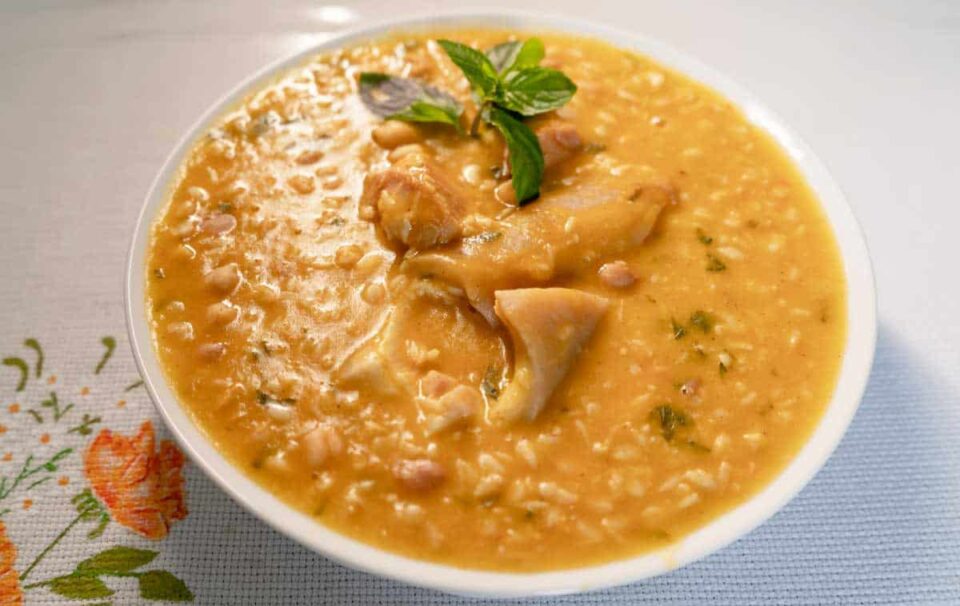Shambar is a hearty, soul-warming dish that perfectly represents the unique combination of ingredients and flavors that make Peruvian cuisine so special.
This thick, flavorful Peruvian soup is characterized by its blend of three types of beans, various meats, and wheat grains, all simmered together in a flavorful broth infused with a medley of aromatic vegetables, herbs, and spices.
Perfect for enjoying on a cold day or for gathering family and friends around the table, shambar is a traditional Peruvian dish that will leave you feeling satisfied and eager to explore other delicious offerings of South American cuisine.
What is Shambar
Shambar is a traditional and hearty Peruvian soup originating from the northern region of Peru, specifically the city of Trujillo. This healthy Peruvian dish is known for its unique combination of ingredients and flavors, which includes three types of beans (fava beans, chickpeas and green peas), various meats (pork, beef and sometimes smoked ham) and wheat grains.
These ingredients are boiled together into a flavorful broth.
The broth is infused with a medley of aromatic vegetables (such as onion, garlic, aji amarillo – a Peruvian yellow chili pepper, and bell pepper), herbs (cumin, oregano, bay leaves, and coriander), and spices.
Shambar is a hearty, comforting meal, often enjoyed on cold days or as a centerpiece for family gatherings.
It is typically served with salsa criolla, a traditional Peruvian side dish made with red onion, Peruvian peppers, and lime juice, as well as crusty bread or rice.
History of Shambar
The origins of shambar can be traced to a blend of Spanish, Andean and Moorish culinary traditions.
During Spanish colonization of Peru in the 16th century the Spanish brought with them various ingredients and culinary techniques, which merged with indigenous Andean culinary practices.
Among these new ingredients were beans, such as fava beans and chickpeas, which became staple ingredients in many Peruvian dishes, including shambar.
The Moorish influence in shambar is evident in the use of wheat grains (trigo), a common ingredient in many Moorish-inspired dishes.
The Moors, originally from North Africa, occupied Spain for centuries, and their culinary influence extended to the Spanish colonies, including Peru.
The history of Shambar is also closely linked to the agricultural practices and local ingredients of the Trujillo region.
The area is known for its fertile lands and abundant harvests, which contribute to the variety of ingredients found in this soup.
The combination of beans, meat and wheat grains make shambar a hearty and nutritious meal, perfect for feeding the local population of farmers and labourers.
Over the years, shambar has become a beloved dish in the region and is today considered a symbol of Trujillo gastronomy.
It is traditionally served on Mondays, although it can be enjoyed any day of the week.
Shambar ingredients


To prepare the famous Peruvian soup you will need the following ingredients.
The ingredient quantities provided for the shambar recipe should yield approximately 6-8 servings.
Ingredients needed:
Beans:
-
- 1/2 cup dried broad beans
- 1/2 cup dried chickpeas
- 1/2 cup dried peas
Meat:
-
- 1 pound pork (shoulder or ribs), cut into small pieces
- 1 pound beef (shank or brisket), cut into bite-sized pieces
- 1/2 pound smoked ham (optional), cut into bite-sized pieces
Wheat grains:
-
- 1 cup wheat kernels (also called wheat berries or trigo)
Aromatic and vegetal:
-
- 1 large onion, finely chopped
- 4 cloves garlic, minced
- 1 aji amarillo (Peruvian yellow chili pepper), seeded and finely chopped
- 1 bell pepper (red or green), seeded and finely chopped
Herbs and spices:
-
- 1 teaspoon ground cumin
- 1 teaspoon dried oregano
- 2 bay leaves
- 1/2 cup chopped cilantro
Accompaniments:
-
- Salsa criolla (red onion, chili pepper and lime juice)
- Crispy bread or cooked rice
Additional Ingredients:
-
- 8 cups water or beef broth
- Salt and pepper to taste
- 2 tablespoons vegetable oil for sautéing the vegetables
Note: These ingredient quantities are approximate and can be adjusted based on personal preference and desired serving size.
How to do Shambar


-
Soaking the beans:
- Rinse the broad beans, chickpeas and peas under cold water. Place them in a large bowl and cover them with plenty of water. Soak the beans overnight, or at least 8 hours, to soften them.
-
Cooking of meat:
- In a large pot, add the pork, beef, and smoked ham (if using) along with enough water to cover the meats. Bring to a boil, then reduce heat to a simmer. Cook the meats for about 1 hour, or until tender. Remove the meats from the pot, reserve the cooking liquid and set both aside.
-
Preparation of the basic soup:
- In a separate large pot or Dutch oven, heat the vegetable oil over medium heat. Add the chopped onion, minced garlic, aji amarillo and bell pepper. Sauté vegetables until soft and fragrant, about 5 to 7 minutes.
- Add the pre-cooked meat, soaked beans and wheat kernels to the pot with the sautéed vegetables. Pour in the reserved meat cooking liquid and 8 more cups of water or beef broth, or enough to cover all ingredients.
-
Cook the soup:
- Bring the soup to a boil, then reduce the heat to a simmer. Cook the soup, partially covered, for about 2 to 2.5 hours, or until the beans and wheat kernels are tender and the soup has thickened. Stir occasionally to prevent the ingredients from sticking to the bottom of the pan. You may need to add more water or broth during cooking if the soup is too thick.
-
Finishes:
- When the beans and wheat grains are tender, add the ground cumin, dried oregano, bay leaves and chopped coriander. Cook the soup for an additional 10 to 15 minutes to allow the flavors to blend. Season the soup with salt and pepper, to taste.
Service and presentation for Shambar


-
Accompaniments:
- Prepare the salsa criolla by combining the thinly sliced red onion, chopped chili pepper and lime juice in a small bowl. Mix well and set aside to allow the flavors to blend.
- If serving with crusty bread, heat the bread in the oven for a few minutes before serving. If using rice, make sure it is cooked and ready to serve.
-
Plating:
- Ladle the shambar into large, shallow bowls or individual bowls, making sure each serving contains a generous portion of beans, meat and wheat kernels.
-
Gasket:
- Sprinkle each bowl with a few freshly chopped coriander leaves for a burst of color and flavor.
- Optionally, you can also garnish the soup with a few slices of chili pepper or a spoonful of finely chopped red onion to add texture and flavor.
-
Serving:
- Place a small plate or dish of salsa criolla on the side, so each guest can add as much as they want to their shambar.
- Serve the warmed crusty bread or cooked rice on the side, allowing guests to enjoy it with the soup of their choice.
Tip: Encourage your guests to mix salsa criolla into their shambar for an added layer of flavor and freshness.


Conclusion
Shambar is a delicious and comforting Peruvian soup that showcases the unique and diverse flavors of Peruvian cuisine.
This hearty dish, with its combination of beans, meat, wheat grains and aromatic vegetables, herbs and spices, provides a satisfying meal, perfect for warming up on a cold day or gathering loved ones around the table.
We invite you to explore more Peruvian recipes on our blog, as well as many other vibrant dishes that make up the delicious world of Peruvian cuisine. Enjoy!


Our blog is all about sharing our love of Latin American foods and drinks. We will provide you with articles and recipes of the best Latin American and Spanish cuisine. Amygofoods was founded in 2003 and is the largest online grocery store offering a wide variety of freshly imported and hard-to-find foods and drinks from across Latin America and Spain.
More information about the author and Amigofoods on our Who we are page.
Please share and spread the love of Latin foods!

